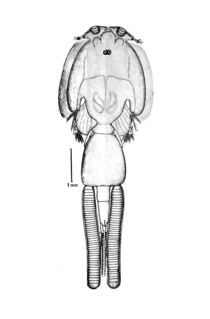
Tantulocarida is a highly specialised group of parasitic crustaceans that consists of about 33 species, treated as a subclass of the class Hexanauplia. They are typically ectoparasites that infest copepods, isopods, tanaids, amphipods and ostracods.

Siphonostomatoida is an order of copepods, containing around 75% of all the copepods that parasitise fishes. Their success has been linked to their possession of siphon-like mandibles and of a "frontal filament" to aid attachment to their hosts. Most are marine, but a few live in fresh water. There are 39 recognised families:

The family Argulidae contains the carp lice or fish lice – a group of parasitic crustaceans of uncertain position within the Maxillopoda. Although they are thought to be primitive forms, they have no fossil record. The Argulidae are the only family in the order Arguloida, although a second family, the Dipteropeltidae, has been proposed.
Deoterthridae is a family of crustaceans in the subclass Tantulocarida, classified under the class Maxillopoda. It contains the following genera: It has been accepted as Cumoniscidae by the World Register of Marine Species.

The Cyclopoida are an order of small crustaceans from the subclass Copepoda. Like many other copepods, members of Cyclopoida are small, planktonic animals living both in the sea and in freshwater habitats. They are capable of rapid movement. Their larval development is metamorphic, and the embryos are carried in paired or single sacs attached to first abdominal somite.

Poecilostomatoida are an suborder of copepods. Although it was previously considered a separate order, recent research showed it to be nested within the Cyclopoida

Diaptomidae is a family of freshwater pelagic copepods. It includes around 50 genera:

The Cyclopidae are a family of copepods containing more than half of the 1,200 species in the order Cyclopoida in over 70 genera.
Paralubbockia longipedia is a species of copepod, and the only member of the family Paralubbockiidae. The family is characterised by the ventral position of the fifth legs, the possession of a separate maxillary palp, and the form of the endopods of the legs and antennae. The closest relatives of Paralubbockia are the family Oncaeidae. Initially placed among the Poecilostomatoida, Paralubbockia is now considered part of the Cyclopoida.
Centropagidae is a family of copepods. Its members are particularly known as plankton in coastal waters and in fresh water in Australia and southern South America. They are also found on subantarctic islands and in lakes in Antarctica.

Caligus is a genus of sea lice in the family Caligidae. The species are parasites of marine fishes and could be vectors of viruses. As of 2017, the World Register of Marine Species includes the following species:
Geoffrey Allan Boxshall FRS is a British zoologist, and Merit researcher at the Natural History Museum, working primarily on copepods.
Misophrioida is an order of copepods, containing the following families:
Nicothoidae is a family of copepods, containing the following genera:
Daniel Boxshall was an English footballer who played as a winger. He made over 140 Football League appearances in the years after the Second World War.

Bogidiellidae is a family of amphipod crustaceans, containing the following genera:
Peniculisa is a genus of marine parasitic copepods in the family Pennellidae.
The clade Multicrustacea constitutes the largest superclass of crustaceans, containing approximately four-fifths of all described crustacean species, including crabs, lobsters, crayfish, shrimp, krill, prawns, woodlice, barnacles, copepods, amphipods, mantis shrimp and others. The largest branch of multicrustacea is the class Malacostraca.

The Hexanauplia constitute a class of crustaceans, comprising two groups: the Copepoda and the Tantulocarida. The former subclass Thecostraca was elevated to class rank and removed from Hexanauplia in 2021.
Basipodellidae is a family of crustaceans belonging to the order Hexanauplia.









